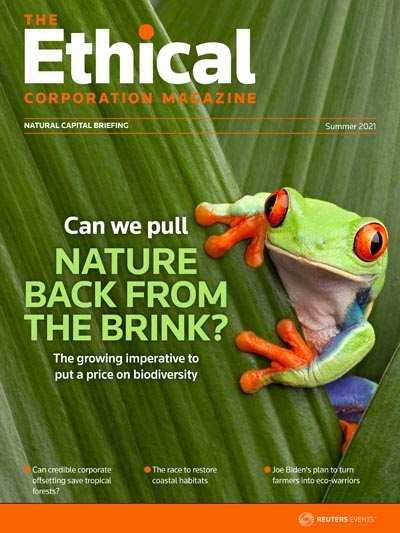Mark Hillsdon reports on the growing impetus to put a value on nature loss so it can be addressed with the same urgency as climate risk
In 2020, for the first time, the World Economic Forum’s Global Risks Report revealed that the five greatest risks the world faced were all environmental, from failure to adapt to climate change, to extreme weather and ecosystem collapse.
In 2021, the threat of a major natural disaster has been displaced by the risk posed by infectious diseases, though there is little reason to celebrate, given that this is another threat directly linked to the destruction of the environment.
Against this backdrop, February’s Dasgupta Review couldn’t have been more timely. Produced by Professor Sir Partha Dasgupta, a Cambridge University economist, the review broke new ground in the way in which it explores the relationship between biodiversity and economics.
The essence of the review is that our way of life is unsustainable. We need to close the gap between what we use and what the Earth is capable of supplying; and businesses have a critical role in helping to achieve it.
What the Dasgupta Review does is nail the link between nature and economics
There was a 40% drop in the stock of “natural capital” per person between 1991-2014, seriously harming nature’s ability to regenerate. The true value of the goods and services that nature provides are not reflected in the market price, the review says, and to fix this we need to start involving nature in financial decisions and think of it in the same way as we do roads and buildings.
The report advocates ditching GDP as a measure of sustainable prosperity, and replacing it with a new indicator of inclusive wealth that measures all forms of capital – natural, social and human. “Balance sheets should not just include what a government or business can gain by exploiting nature. They should also include what they will lose,” it suggests.
Sir Roger Gifford, a banker by trade, was on the report’s advisory panel. He says it’s significant that the report was commissioned by the Treasury of one of the world’s leading economies, rather than an NGO.
Biodiversity has been under threat for years, he explains, but no one has ever tried to put figures or value round it. “What the Dasgupta Review does is nail the link between nature and economics,” he says.
Business for Nature is a coalition of businesses and conservation organisations that has set out to articulate the argument for stopping nature loss. It’s aim, explains director of communications, Lucy Coast, is to give policymakers the courage to develop a new global agreement on nature.
Last year, over 700 global companies, including Burberry, Citigroup and Proctor & Gamble, signed its call for action, Nature is Everyone’s Business, which pushed governments to adopt a mission to reverse nature loss by 2030.
Businesses are starting to wake up to the fact that natural capital is the very foundation on which we all rely
It is also helping companies to understand the multitude of risks they face because of nature loss, from operational and reputational risk, to financial threat and the possible pitfalls of not being prepared for an anticipated new raft of regulations.
“We've seen businesses that have started to talk about these issues in a way that just a few years ago probably would have been unimaginable,” explains Coast. “Businesses are starting to wake up to the fact that it [natural capital] is the very foundation on which we all rely.”
One area in which Business for Nature hopes global governments will act quickly is on subsidies.
The Dasgupta report says that between $4-6tn a year is handed out to industrial agriculture companies in subsidies, with most only serving to destroy natural capital rather than protect it. "You make money as a landowner if you clear it and sell it for building,” explains Maelle Pelisson, advocacy director at Business for Nature, “but you don’t get any financial support if you preserve it.

“What we need to do is divert those investments towards behaviour that restores, replenishes and conserves nature,” she says. “Anything that goes to supporting over-exploitation should stop.” This much-needed financial boost could be invested in innovation, the circular economy and new business models, she adds.
Business for Nature works closely with the Capitals Coalition (formerly the Natural Capital Coalition), which brings together leading global initiatives and organisations around managing natural, social and human capital. “There is no way of measuring one without the other because they are so interlinked,” explains collaboration manager, Tim Polaszek.
“Historically we've gone through a siloed approach to doing these things, whereas businesses now see the advantage of looking at them [capitals] holistically; they see the inter-connection."
An estimated $967bn a year is required to reverse the decline in biodiversity by 2030
The coalition uses a system of protocols to help organisations identify, measure and value their impacts, while its We Value Nature campaign helps businesses that are at the beginning of their journey. It mixes assessments, training programmes and advice on how to overcome barriers such as a lack of internal buy-in and institutional inertia. There is also a new push to address the specific needs of smaller businesses, says Polaszek, which often supply larger businesses, and have fewer resources to address issues such as biodiversity policies and zero-carbon commitments.
According to Credit Suisse, an estimated $967bn a year is required to reverse the decline in biodiversity by 2030. In January, the bank released its Unearthing Investor Action on Biodiversity report, which revealed that while investor interest in ESG investments has accelerated in recent years, funding for biodiversity has not kept pace.
With global biodiversity finance making up just 0.1% of global GDP, conservation and biodiversity funding still depends on governments and philanthropic donations.

But while the vast majority of the investors interviewed for the Credit Suisse report described themselves as “very concerned about biodiversity loss”, a staggering 72% did not assess the impact of their investments on biodiversity.
One of the key reasons cited for this lack of action was that asset managers are struggling to identify and consider biodiversity-linked investment opportunities, and that biodiversity needs to be made more digestible and measurable for investors.
Similarly, biodiversity risk is a big blindspot for the insurance industry, according to a new ShareAction report, which ranks 70 of the world’s largest insurance companies on their response to climate change, biodiversity and human rights.
No insurer has a comprehensive strategy for measuring and managing impacts and dependencies on nature
According to ShareAction, no insurer has a comprehensive strategy for measuring and managing impacts and dependencies on nature, and no insurer has targets to minimise impact on biodiversity loss. Just three insurers said they are planning to release a biodiversity policy in the next 12 months.
The Dasgupta report argues that new global standards are needed to help businesses and investors integrate nature into their decision-making, using clear data and metrics in the same way that climate-related impacts are now measured.
In February, BNP Paribas announced that it had partnered with CDP to develop a global corporate biodiversity reporting framework, which will allow for the integration of biodiversity data into investment, business and policy decision-making.

Antoine Sire, director of company engagement at BNP Paribas, is one of three co-chairs of the Task Force on Nature-related Financial Disclosures, which was set up last year to build on the work of the Task Force on Climate-related Financial Disclosures, and enables companies to address nature- and climate-related risks simultaneously.
In March, France expanded its Article 173 legislation, which requires financial institutions to report on their climate-related impacts, decreeing that from 2022 they will also have to disclose biodiversity risk. Like the new EU Sustainable Finance Disclosure Regulation, the new decree adopts the concept of double materiality, meaning that they must disclose both the extent to which their financial activities depend on climate and biodiversity, and also have an impact on climate and biodiversity.
BNP Paribas is already doing that in its lending practices, explains Robert-Alexandre Poujade, an ESG analyst at BNP Paribas’s Sustainability Centre, which has scored more than 12,000 companies on their risks and opportunities around natural capital.
All of this political will is fantastic, but you have to translate it into implementable, binding laws
“We do research around identifying risk and opportunity for our portfolio managers, so we can recommend good companies to them,” Poujade says. “The aim is not to monetise nature and to exploit it... the aim is to protect it, [and] to protect it, you need to put a value to it.”
In February, BNP Paribas announced that, post 2025, it would only work with companies with a strategy to achieve zero deforestation. The move is particularly aimed at soy and beef production, and the role it plays in land clearance.
Gifford points out that some of the biggest initiatives designed to protect natural capital are being led by the world's largest importers of natural goods – such as Tesco, Cargill, Unilever. “The more transparent we are about companies̕ operations... the more the investor and the shareholder learns about their operations and the more they have to report, the greater the potential reputational damage to their share price if they get it wrong.”

Last year was meant to be the “Super Year for Nature”, but while Covid-19 largely put paid to that, it’s hoped that 2021 will take its place. The Dasgupta Review has helped catapult natural capital into the limelight, while 50 countries have now signed the High Ambition Coalition for Nature and People, a new commitment to protect 30% of the world's land and oceans by 2030, launched at the One Planet Summit in January. Notably, that includes the U.S. under the presidency of Joe Biden.
Supporters will be promoting the 30 by 30 strategy at the much-delayed UN Biodiversity Conference (COP15), which is now scheduled to take place in October. The meeting is expected to usher in new legally binding legislation and adopt a new global agreement on nature that will set the direction of travel for the next 30 years and is already being dubbed a Paris Agreement for Biodiversity.
“All of this political will is fantastic, but you have to translate it into implementable, binding laws, incentives and investments,” says Coast of Business for Nature. “That's the next step, and that's why this global agreement is so fundamental.”
Mark Hillsdon is a Manchester-based freelance writer who writes on business and sustainability for The Ethical Corporation, The Guardian, and a range of nature-based titles including CountryFile and BBC Wildlife.
This article is part of The Ethical Corporation summer 2021 in-depth briefing on natural capital. Click on the cover to download your digital copy for free.
Main picture credit: Anna in Sweden/Shutterstock



